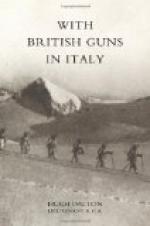At the western end the Plateau was bounded by the descent to the Val d’Astico. On the northern side of the Plateau rose a formidable mountain range, the chief heights of which, from west to east, were Monte Campolungo, Monte Erio, Monte Mosciagh and Monte Longara. This range was thickly wooded with pines, among which our guns did great damage. I always more regretted the destruction of trees than of uninhabited houses, for the latter can be the more quickly replaced. This range was pierced by only four valleys, through each of which ran roads vital to the Austrian system of communications, the Val Campomulo, the Val di Nos, the Val d’Assa and the Val di Martello. The Austrians had also a few roads over the top of the mountains, but these were less good and less convenient.
Along the southern side of the Plateau ran another ridge, less mountainous than the ridge to the north, and completely in our possession. This ridge also was thickly wooded, and pierced by only a few valleys and roads. The road we came to know best was the continuation of the wonderful road up from the plain, through Granezza to the cross-roads at Pria dell’ Acqua, and on through the Baerenthal Valley to San Sisto. Thence it led through the front line trenches into the town of Asiago itself. At Pria dell’ Acqua, a most misleading name, where there was no water, but only a collection of wooden huts, another road branched off westwards, running parallel to the front line, behind the southern ridge of the Plateau.
The Italian Engineers had created a magnificent network of roads in this sector of the Front. Before the war there had been only one road into Asiago from the plain. Now there were half a dozen, all broad and with a fine surface, capable of taking any traffic. And, in addition, there were many transverse roads, equally good, joining up and cutting across the main routes at convenient points.
When the British troops took over this sector in March, the whole Plateau, properly so called, was in Austrian hands. It had been taken last November in the mountain offensive which followed Caporetto. At one perilous moment the Austrians had held San Sisto and their patrols had passed Pria dell’ Acqua, but they had been thrown back by Italian counter-attacks to the line they now held. Our front line ran along the southern edge of the Plateau, and, on the right, along the lower slopes of the southern ridge, just inside the pine woods. On the left, further west, it ran mostly on the flat and more in the open. Where the Val d’Assa turned west, our front line ran on one side of the shallow gulley and the Austrian on the other. The Austrian front line was completely in the open. The first houses of Asiago were only a few hundred yards behind it.




